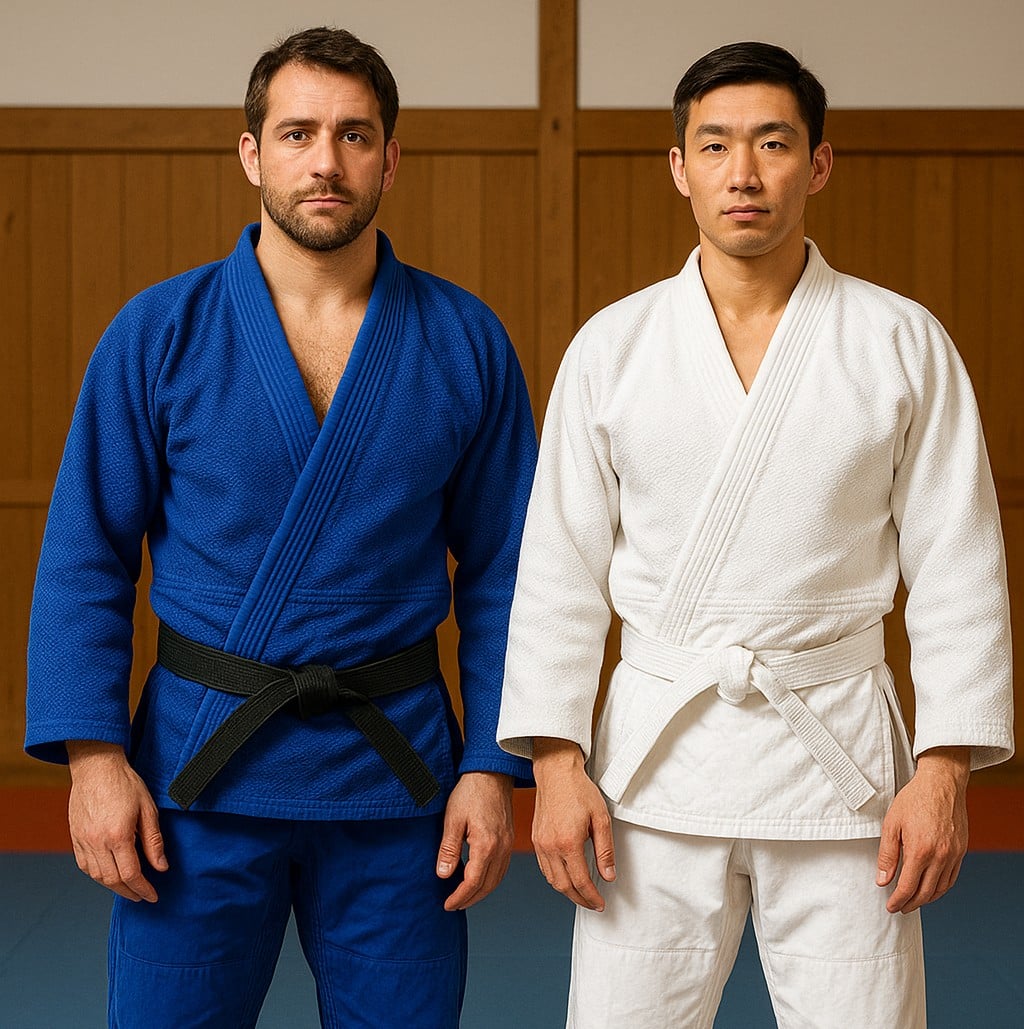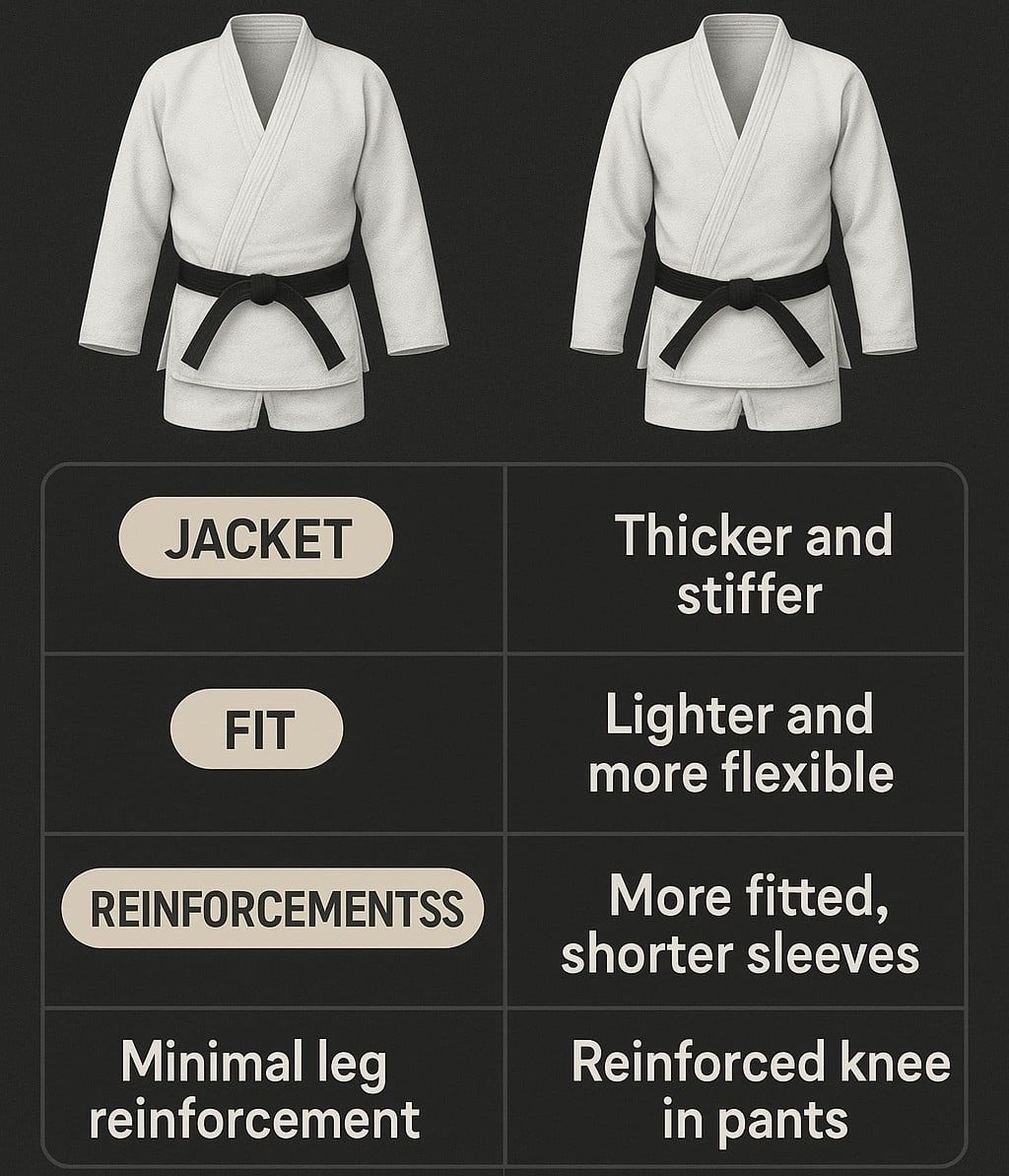At first glance, a judo gi and a BJJ gi might look almost identical. They’re both heavy-duty uniforms built to withstand grabs, grips, and intense physical exertion. But when you put them side-by-side, or better yet, wear them in their respective disciplines, the differences become clear. Whether you’re cross-training, shopping for your first gi, or just curious, here’s a breakdown of how the two uniforms differ.

Fit and Cut
The most noticeable difference between a judo gi and a BJJ gi is the fit. Judo gis are generally looser and baggier, especially in the sleeves and torso. This extra fabric provides opponents with more to grip, which aligns with the emphasis in judo on throws and sleeve control.
BJJ gis, on the other hand, are tailored with a much slimmer fit. Sleeves are tighter, the pants are more form-fitting, and the jacket usually sits closer to the body. This minimizes the material your opponent can grab during scrambles, passes, and submissions, giving you a slight competitive edge. If you’re looking to buy your first one, check out this curated list of the best BJJ GIS for every budget and style.
Material and Weave
Judo gis are typically made from thicker, heavier cotton, especially in competition models. This helps withstand the constant pulling and tugging during throws and stand-up grip battles. A typical competition judo gi might weigh 950 gsm or more.
BJJ gis come in a wide range of weights and weaves, from lightweight travel gis to ultra-heavy competition sets. While a heavier gi might weigh around 550–750 gsm, most BJJ practitioners favor a balance of durability and comfort. Pearl weave is the most common, offering strength without being overly bulky. Some of the highest quality gis today are coming out of Japan; this guide to Japanese BJJ gi brands breaks down the craftsmanship and what makes them stand out.
Reinforcement and Stitching
Both GIs are reinforced at stress points, such as the collar, armpits, and knees. However, BJJ gis often have extra reinforcements in the collar and lapel to make it harder for opponents to establish grips. Judo gis tend to have slightly softer collars, which makes sense given the emphasis on throwing over choking.
Skirt Length and Collar Thickness
A judo gi jacket typically has a longer skirt that reaches closer to the thighs. The lapels are also broader and thinner compared to most BJJ gis. In contrast, BJJ jackets usually have a shorter skirt and a thicker collar. The shorter cut improves mobility on the ground, while the thick collar discourages lapel chokes.

Rules and Competition Requirements
If you’re planning to compete, these are the areas where the differences matter. The IBJJF, the largest BJJ competition body, has strict gi measurement rules and often disallows overly loose-fitting judo gis. Likewise, judo tournaments governed by the IJF require regulation judo gis and won’t allow slim-cut BJJ gis, especially if the sleeves are too tight to grip.
Aesthetic and Branding
BJJ gis often feature more colorful designs, patches, and brand logos. It’s common to see contrast stitching, detailed embroidery, and unique stylistic flairs. Judo gis are typically more conservative, often featuring white or blue colors with minimal branding, especially in competition.
Which One Should You Use?
If you’re doing judo, use a judo gi. It’s built for the sport and adheres to tournament rules.
If you’re training BJJ, a BJJ-specific gi will feel better, fit better, and make a difference during rolling.
For cross-training, you can use a judo gi in BJJ practice, especially in casual settings, but be aware that the extra fabric may work against you on the ground.
Summary
While judo and BJJ share a common ancestry, the gear has evolved with the sports. A judo gi is built for powerful throws and gripping battles on the feet. A BJJ gi is optimized for guard work, scrambles, and submissions on the mat. Choosing the right one isn’t just about aesthetics—it’s about performance and purpose.
Also, don’t forget that proper GI care makes a huge difference. If you’re unsure how to keep yours in top condition, here’s a detailed guide on how to wash your gi properly to avoid shrinking and maintain durability.
Understanding the differences ensures you train more effectively and stay within the rules, whether you’re on the tatami or the mats




